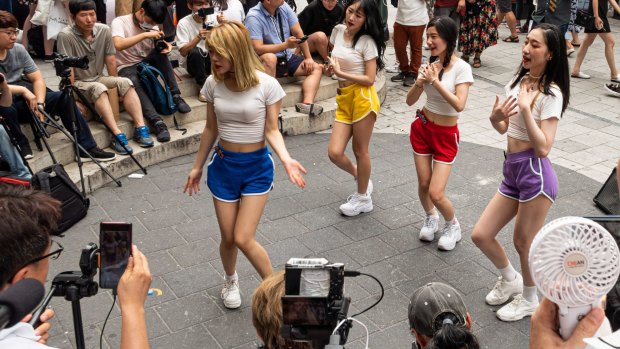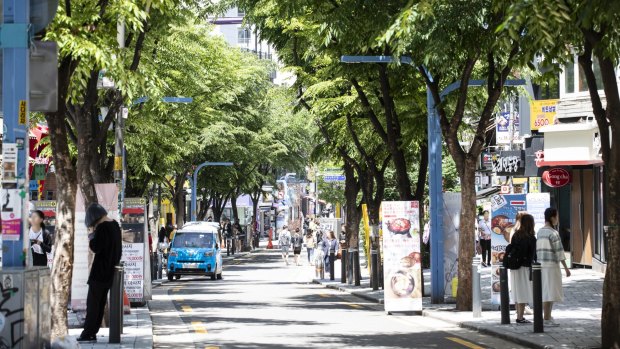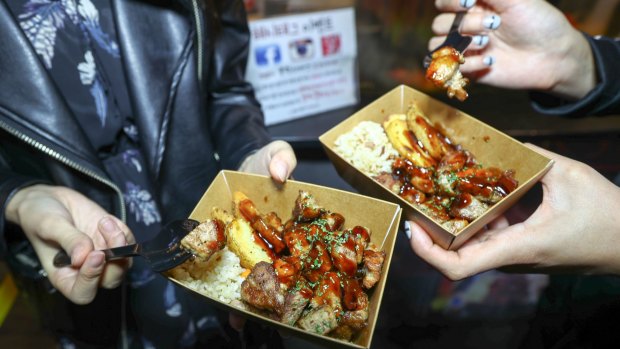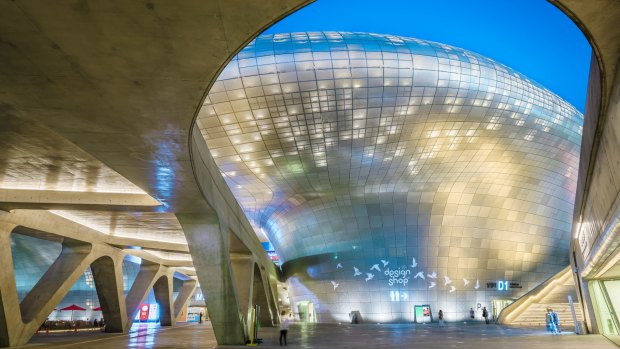This was published 2 years ago
Seoul, South Korea travel guide: Underrated city could be the next big thing for Australian travellers
By Craig Platt

Young Korean women dance to K-Pop in Hongdae, a hip district popular with students.Credit: iStock
The music blares from a series of portable sound systems, one tune bleeding into another as I walk along a pedestrian mall.
In front of each speaker, several young women, mostly students, dance to pop tunes for crowds of onlookers. Between the dancers, one lonely young man stands in front of a microphone, belting out a song to a recorded backing track.
I'm in Hongdae, Seoul, a neighbourhood named after the nearby Hongik University and filled with cafes, bars and clubs that appeal to the many young people who live and study in the area.

Seoul's Hongdae district.Credit: Korea Tourism Organization
Seoul may not attract as many tourists as some of Asia's other mega-cities, but it certainly has enough quirks and culture to deserve more attention - and the world finally seems to be catching on.
South Korea's cuisine has enjoyed a surge in popularity over the past decade and its pop music, dubbed "K-Pop", has moved beyond Psy's global novelty hit Gangnam Style to develop a huge fan base in the West (you've probably heard of boy band BTS by now). To top it off, Korean director Bong Joon Ho's Parasite took out the award for best picture at last year's Oscars, becoming the first foreign language film to do so.
The timing looked good for Jetstar, which launched Australia's first budget flights to Seoul in December 2019, from the Gold Coast.

Food is everywhere in Seoul, though street food is mostly popular with tourists these days.Credit: Korea Tourism Organization
Initially, the purpose of this route was to bring Korean tourists to Queensland, but in the longer-term, Jetstar hoped for a similar experience to its Japan routes and that over time Australian tourists would embrace South Korea's capital in the same way we have flocked to Tokyo over the past 10 years.
It might take a few more years now, thanks to the pandemic. Since COVID-19 hit, Jetstar has been forced to shelve the route along with all its other international flights, but the prospect of a travel bubble with South Korea remains a possibility, albeit one that looks some time off given a resurgence in infections. However, the death rate remains low by global standards and South Korea already plans to start allowing vaccinated visitors to skip quarantine (with some restrictions).
Seoul, a metropolis of almost 10 million inhabitants, remains a mystery to most Australians. Just 82,000 Australians visited South Korea in 2019, according to Australian Bureau of Statistics figures. Compare this to Japan, which has enjoyed growth of more than 320 per cent over the past decade and had more than half a million visitors the same year.

Dongdaemun Design Plaza - a Zaha Hadid-designed curving building of gleaming metal, lights up at night.Credit: iStock
The sheer size of Seoul can make it a daunting destination for first-time visitors, as I discovered, particularly since it doesn't have obvious, iconic sights that other cities offer - think Sydney's harbour, New York's Times Square or London's Big Ben. Instead, visitors need to scratch beneath the surface to find Seoul's highlights.
It's also a city without a true centre - it's spread out into various large districts, including the famous Gangnam which, far from being a small hipster enclave Psy's song might lead foreigners to believe, covers a whopping 40 square kilometres and is the city's third-largest district.
But its size does not make the city difficult to navigate. In fact, Seoul has one of the most extensive and inexpensive train systems in the world. There is virtually no place in this vast city you cannot reach by train.
The only catch is that you'll find Google Maps doesn't work here due to security requirements from the Korean government (tensions with North Korea remain high). As such, you'll need to download a local maps app such as KakaoMap or Naver in order to navigate, or just do it the old-fashioned way with a paper map from the local tourism office.
What you won't have any trouble finding is food. It's everywhere in Seoul, from back alley restaurants in ancient traditional buildings, street food vendors selling hot dogs covered in potato and batter, to novelty restaurants where everything is toilet and faeces themed (seriously).
I take a food tour one evening with Intrepid Travel's Urban Adventures. Our guide, Lee, starts us off with a few street food stalls. These places are ubiquitous throughout the city, offering delicious snacks like barbecued meat skewers, fish cakes with soup, green onion pancakes and kkul-tarae, a variation of the Chinese dessert "dragon's beard", which consists of thousands of strands of sweet dough folded around a filling of nuts or chocolate. Lee tells us that the main clientele for these vendors are now tourists (I notice most of the other customers are also speaking English) as their popularity with locals has waned.
The next day I take the train to Hongdae to check out VR Square, a virtual reality theme park spread across five storeys. It's one of several in the city, where the locals are justifiably proud of the country's reputation as a centre for cutting-edge technology. I pay 29,000 won (about $34) for a three-hour Free Pass, which gives me unlimited plays of the various experiences on offer. The highlight is "Mortal Blitz", a Halo-like first-person shooter that allows you to walk around and feel like you've truly stepping inside a game. As monstrous aliens come at me from the dark, I find myself ducking and weaving to try and avoid them or to get a better angle for my shots. It's huge fun.
Heading back to the train station is where I come across Hongdae street performers, dancing away as the sun begins to set.
I take the train back to the Dongdaemun district, where my hotel is located, strolling past the Dongdaemun Design Plaza - a Zaha Hadid-designed curving building of gleaming metal, lit up at night by a spectacular lighting display.
Beneath this symbol of modern Seoul, an ancient water gate can be seen - a remnant of the city's former fortifications. It's a perfect juxtaposition between the city's ancient traditions and its embrace of modern culture and technology - another sign the city has the potential to be the next big thing, once we can travel again.
THE DETAILS
MORE
FLY
Australia's borders are now closed under the federal government's COVID-19 restrictions. You can only leave the country after obtaining special permission from Border Force.
Jetstar's international network is currently suspended but the airline hopes to restart the route when overseas travel resumes. See Jetstar.com
STAY
The Novotel Ambassador Seoul Dongdaemun is in the Dongdaemun district, close to the Dongdaemun History and Culture Park. Rooms from 330,000 won (about $A380).
The writer travelled as a guest of Jetstar.
See also: North Korea's secret tunnels into South Korea are open to tourists
See also: No pointing, no ripped jeans: Rules for visiting world's tensest border
Sign up for the Traveller Deals newsletter
Get exclusive travel deals delivered straight to your inbox. Sign up now.